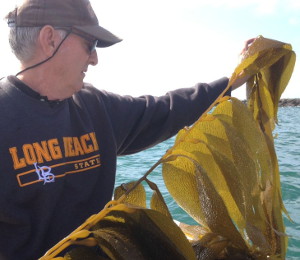
Should you be worried?
When I mentioned using kelp as a seasoning in order to achieve a healthy amount of iodine in my daily diet, some people on Twitter began warning me to think about Fukushima and the radiation level that might be contained in seaweed, whether the seaweed is from Japan, from waters near California, or the waters on the coast of Maine.
I hadn’t thought about that, so I watched videos of people applying their Geiger counters to packs of seaweed, laptops, floors, walls… and I read quite a lot of material written about radiation.
The most authentic, and convincing account I read was written by Dr. S. Akizuko of St. Francis Hospital in Nagasaki, who survived the atomic bomb in World War II. Dr. Akizuko writes:
“On August 9, 1945, the atomic bomb was dropped on Nagasaki. Lethal atomic radiation spread over the razed city. For many it was an agonizing death. For a few it was a miracle. Not one co-worker in the hospital suffered or died from radiation. The hospital was located only one mile from the center of the blast. My assistant and I helped many victims who suffered the effects of the bomb. In the hospital there was a large stock of miso and tamari. We also kept plenty of brown rice and wakame (seaweed used for soup-stock or in miso soup). I had fed my co-workers brown rice and miso soup for some time before the bombing. None of them suffered from atomic radiation. I believe this is because they had been eating miso soup.” From Surviving Harmful Radiation by Julie Ferre. (Dr. Akizuki wrote How We Survived Nagasaki ~ London: Quartet Books, 1981.
And then, there’s this: studies have proven that the isoflavone genistein found in soy miso is associated with a decreased risk of cancer. I don’t know much about Miso, I’ve only had it a few times, at restaurants with far more connoisseur type people than me. My understanding, however, is that Miso traditionally has Wakame seaweed in it.
Research shows that Isoflavone Genistein in soy tends to agravate hypothyroidism when there is a lack of iodine. Wakame is a source of iodine. From Integrative Medicine E-Book By David Rakel
Abstract: Seaweed and soy foods are consumed daily in Japan, where breast cancer rates for postmenopausal women are significantly lower than in the West. Dietary Seaweed Modifies Estrogen and Phytoestrogen Metabolism in Healthy Postmenopausal Women, American Institute of Nutrition, 2009.
In 1980, the Japanese National Cancer Center did an epidemiological study showing that those who ate miso soup daily were not only less likely to suffer from cancer, but also stomach issues and heart disease. Since then, countless studies have revealed similar research, linking anti-cancer benefits directly to intake of miso soup.
But, Fukushima…
Which brings us to Kelp Watch. Kelp Watch was a scientific campaign, based on collaboration between Dr. Steven L. Manley, Department of Biological Sciences, California State University- Long Beach, and Dr. Kai Vetter, UC Berkeley and Lawrence Berkeley National Laboratory. Kelp Watch was designed to determine the extent of possible radiation contamination of our kelp from seawater arriving from Fukushima in 2014.
Kelp Watch has officially ended with the analyses of samples collected during the spring and summer of 2016. There was no indication that radioactivity from Fukushima became incorporated in the coastal kelp beds sampled.
So, I feel safe ordering Kelp Seasoning to increase my daily intake of iodine.
Dried Seaweed ~ 4,500 mcg. A whooping 3,000% of the iodine we need in a day is in 1/4 ounce. Which is why eating sushi just one or two times a week is extremely healthy for your thyroid. Because I’m not a fan of fishy tasting things, munching dried seaweed, like dulse, sea lettuce, doesn’t work for me. The dried seaweed flakes, substituting for sodium salt, has good reviews, so I’m trying it. Just a sprinkling is all you need. I’m pretty sure my daily iodine intake is too low for my thyroid to be healthy, so this will be good..
Spirulina ~ 15 mcg per serving. I’ve been buying Nutrex Spirulina, from Hawaii. Nutrex doesn’t have iodine on the Supplement Facts label, so I called. They were helpful and said the nutrient results for their Spirulina are several pages long, so they only included the ones that are “industry standard” on their label. I like Nutrex Astaxanthin, which I why I bought their Spirulina. I’m delighted the Spirulina has B12 in it and 2 grams of protein per serving.


